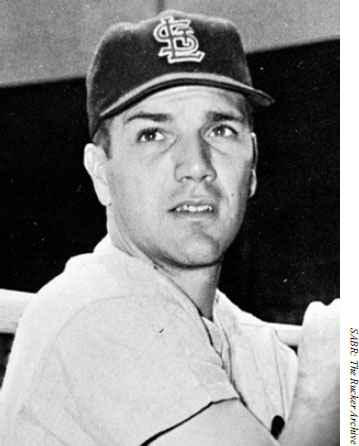The 1955 Hamilton Cardinals: Why Did the Pony League Champions Franchise Fold in May 1956?
This article was written by Allen Tait
This article was published in When Minor League Baseball Almost Went Bust: 1946-1963
Ken Boyer. (SABR-Rucker-Archive)
Introduction
The Hamilton Cardinals of the Pennsylvania-Ontario-New York (PONY) League experienced a rapid rise and fall between 1955 and 1956. The team won the 1955 PONY League championship in September 1955, yet ceased operations in May 1956. The Hamilton team was the primary reason for the “O” in the PONY acronym; it had operated continuously since the league was founded in 1939 (excluding the war years 1943-1945 when the league operated exclusively in the United States). The only other Ontario-based PONY League team had been the London Pirates (1940-1941). The demise of the Hamilton Cardinals led to the league being renamed the New York-Pennsylvania League in 1957.
Hamilton made the postseason in three of its first four seasons prior to the wartime hiatus. Its return to the PONY League in 1946 was a challenge; Hamilton did not make the postseason again until 1948. That started a string of six consecutive playoff appearances before the team failed to make it in 1954.
Before the 1955 season, a total of 20 Hamilton players had made the major leagues with careers lasting from a few games to many seasons. The two most recognizable names played on the third-place Hamilton Cardinals in 1950:
Ken Boyer was primarily a third baseman and hit .342. He also pitched in 21 games for Hamilton, posting a record of 6-8 with a 4.39 ERA. Boyer was the starting third baseman for the St. Louis Cardinals from 1955 through 1965, compiling a batting average of .293 with 255 home runs and 1,001 RBIs over those 11 seasons. Boyer played four more seasons with the New York Mets, Chicago White Sox, and Los Angeles Dodgers before retiring in 1969. His final career statistics include a .287 batting average, 282 home runs, and 1,141 RBIs.
Stu Miller was the ace of the Hamilton staff, starting 27 games and compiling a 16-13 record with a 3.21 ERA. Miller went on to have a 16-year major-league career with the St. Louis Cardinals, Philadelphia Phillies, New York/San Francisco Giants, Baltimore Orioles, and Atlanta Braves, compiling a lifetime record of 105-103 with a 3.24 ERA, plus 153 saves.
The 1955 Championship Season
Hamilton had only two holdover players from the 1954 team, outfielder Arthur Resma, who had provided respectable offensive production in 1954 (.285/9/76), and 1954 backup catcher Bill Brown (.252/0/15 in 42 games). The influx of new players appeared to mesh from the start as Hamilton led the league throughout the season.
On May 26, they had a 17-5 record and a 4%-game lead over Wellsville and Corning.1 By the PONY League all-star break, The Sporting News reported, “The Hamilton Cardinals were running away with the race, leading by ten and one-half games.”2
However, the league was facing financial challenges with two franchises.
“The Directors of Hornell (Pony), who had voted to drop out of the league, rescinded the decision, June 27, after a fund-raising campaign produced more than $3,500 to meet the Dodgers’ operating deficit. The drive will continue in an effort to keep the club going for the remainder of the season. … With Hornell’s troubles apparently solved, the Pony League faced a new difficulty when General Manager Mike Cannavano of Erie announced the Senators ‘were ready to call it quits.’ However, Erie fans rallied to the support of the club, with donations and ticket purchases, and Cannavano said T think we can make out all right.’… In an effort to aid tail-end clubs, the directors of the Pony League have voted to split the season.”3
However, the split-season plan was not implemented. On July 8, National Association President George Trautman ruled that the plan’s approval required a unanimous vote. Hamilton and seventh-place Jamestown opposed the split season. Also rejected was a proposal by Pony League President Vince McNamara to hold a six-team round-robin playoff in lieu of the four-team Governors Cup series. Corning (second place) and Wellsville (fourth place) opposed.4
On August 4, Hamilton had a 9%-game lead over second-place Bradford. However, despite being in playoff contention, Bradford was facing financial pressure:
“Fans at Bradford (Pony) burned more than 300 season tickets at home plate during a double-header with Jamestown, July 30, and pledged cash support of the club at $1 admission per game to enable the Phillies to finish the season. Mayor Hug Ryan proposed the ‘waiving’ of the season tickets, which were sold at the beginning of the year at a bargain $10 each. With all-cash admissions, at present average attendance of 800, it was believed the Phillies would raise sufficient funds at the box office to remain in operation.”5
Late in the season, second-place Wellsville, 13% games behind, achieved an accomplishment against Hamilton by ending its streak of 76 consecutive games without being shut out. Wellsville pitchers Don Nottebart and Bob Stoico pitched back-to-back five-hit shutouts, with Wellsville winning the games, 7-0 and 5-0.6
Hamilton finished the 1955 regular season in first place with an 82-43 record, leading the league in runs scored (836) and fewest runs allowed (572). This was a significant improvement over the 1954 team, which had scored 783 runs and allowed 792 runs.
The top four starters had a combined record of 61-24, led by Gary Geiger (20-7 with a 1.98 ERA). Geiger did make the major leagues in 1958, forging a 12-year career as an outfielder with a career batting average of .246. Reliever Paul Toth (three seasons) also reached the majors. The Hamilton hitting was led by 32-year-old second baseman Ed Lyons, who batted .350 and hit 17 home runs. Lyons was the only Hamilton player with previous major-league experience, having played for the 1947 Washington Senators and hitting .154 in 26 at-bats.
Hamilton defeated the fourth-place Wellsville Braves (68-58) two games to one in round one of the playoffs.7 Wellsville was led by future major-league pitcher Don Nottebart (18-11, 2.57). Nottebart had a nine-year major-league career with a record of 36-51/3.65, including a 1963 no-hitter against the Phillies. Wellsville catcher Ron Henry (42 games) later reached the majors, and 38-year-old second baseman Alex Monchak had previous major-league experience, having appeared in 19 games for the Philadelphia Phillies in 1940.
The third-place Corning Red Sox (69-57) upset the second-place Bradford Phillies (74-51) two games to one in the other semifinal. Hamilton proceeded to sweep Corning in three games in the final to win the PONY League championship.8 Corning starter Ken McBride (10-9, 3.81) later had a seven-year major-league career, primarily with the Angels, compiling a 40-50 record with a 3.79 ERA and three All-Star Game selections. The only other future major leaguer on the team was Bill Monbouquette. He appeared in only one game for Corning, a start that lasted two innings in which he yielded six hits and three earned runs in a no-decision. Monbouquette went on to have an 11-year major-league career, amassing a 114-112/3.68 record, and was chosen for four All-Star teams, including 1963, when he was a 20-game winner for the Red Sox.
PONY League Attendance
PONY League attendance fluctuated over four seasons, with Hamilton being one of the stronger franchises.
| Year | Total Attendance |
Hamilton Attendance |
Rank |
|---|---|---|---|
| 1952 | 339,764 | 82,286 | 1st |
| 1953 | 291,325 | 53,291 | 1st |
| 1954 | 375,981 | 41,379 | 5th |
| 1955 | 339,040 | 53,989 | 1st |
As noted above, three of the eight PONY League teams (Hornell, Erie, Bradford) disclosed that they had experienced financial difficulties that required civic support to complete the season. The final standings for 1955, including attendance, were:
| Team | W-L | Attendance |
|---|---|---|
| Hamilton Cardinals | 82-43 | 53,989 |
| Bradford Phillies | 74-51 | 35,979 |
| Corning Red Sox | 69-57 | 42,919 |
| Wellsville Braves | 68-58 | 45,799 |
| Erie Senators | 66-60 | 53,151 |
| Hornell Dodgers | 50-76 | 27,314 |
| Jamestown Falcons | 48-78 | 32,700 |
| Olean Oilers | 46-80 | 47,189 |
1956 Hamilton Red Wings: The Final Season
The 1955 success of the franchise on the field and at the box office did not provide a guarantee for a 1956 affiliation renewal with the parent St. Louis Cardinals. An indication that the future of the Hamilton Cardinals was in doubt appeared shortly after they won the 1955 championship. In an interview with August Busch, owner of the St. Louis Cardinals, the reporter noted that the Cardinals had 19 farm clubs in 1955, some of which were owned outright. Busch was asked if there would be any reduction in the farm system in 1956. Busch responded:
“We’re going to take a serious look at our minor league setup. Our aim is a basically sound, well-balanced system rather than mere numbers.”9
All of which led to the Cardinals dropping four minor-league affiliates, including Hamilton.
Hamilton was unable to replace the lost Cardinals affiliation and began the 1956 season rebranded as the independent Hamilton Red Wings. To make matters more challenging, Hamilton did not have any players return from the 1955 championship team. The efforts to operate as an independent franchise proved unsuccessful, and the Red Wings, as well as the New York Yankees-affiliated Bradford Yankees, folded on May 16, 1956. The Sporting News summarized the contributing factors: Bad weather in early May hurt the league; 25 of the first 40 scheduled games were postponed. This particularly hurt the finances of the independent Hamilton Red Wings. The league did consider assuming operation of the franchise; however, with the Bradford Yankees also experiencing financial problems, both franchises were folded on May 16.10
The final 1956 standings were:
| Team | W-L | Attendance |
|---|---|---|
| Wellsville Braves | 74-56 | 30,470 |
| Corning Red Sox | 68-55 | 33,450 |
| Olean Oilers | 68-58 | 27,281 |
| Hornell Dodgers | 57-58 | 20,334 |
| Jamestown Falcons | 52-62 | 19,757 |
| Erie Senators | 45-74 | 28,223 |
| Hamilton Red Wings | 6-8 | 1,200 |
| Bradford Yankees | 3-9 | 1,258 |
| Total Attendance | 161,973 |
With the demise of the sole Canadian franchise and falling attendance, the league restructured as the New York-Pennsylvania League beginning in 1957. The original eight franchises included newcomers Batavia and Elmira, plus former PONY League cities Bradford, Corning, Erie, Jamestown, Olean, and Wellsville. Once again, however, there were difficulties with Bradford, now an independent team named the Blue Sox. They struggled with a 5-15 record, being outscored 130-75 and drawing only 1,700 fans. The franchise folded on May 23 and was relocated on May 28 to Hornell as the Redlegs, an affiliate of the Cincinnati Reds.
Despite the start-up challenges in 1957, the New York-Pennsylvania League operated continuously as a Class-A short-season league until 2019, when Major League Baseball initiated a radical overhaul of the minor-league system. Three franchises—Aberdeen, Brooklyn, and Hudson Valley—remained affiliated with major-league teams. The teams in Lowell, Massachusetts, and Staten Island, New York, were eliminated, while all the other clubs drifted over to a variety of independent or college summer leagues. After more than 60 years, the New York-Pennsylvania League ceased operations.
ALLEN TAIT is a longtime SABR member and retired fraud investigator residing in Grimsby, Ontario. Allen is currently chapter leader for the Hanlan’s Point (Toronto/Southwestern Ontario) Chapter of SABR. Allen now applies his investigative skills to baseball research and has contributed to the SABR books Our Game Too: Influential Figures and Milestones in Canadian Baseball and We Are, We Can, We Will: The 1992 World Champion Toronto Blue Jays. Allen also wrote the Toronto Blue Jays section for the SABR BioProject’s Team Ownership Histories.
Acknowledgments
This article was edited by Marshall Adesman and fact-checked by Mark Richard.
Sources
Data regarding the teams and players is drawn from Baseball-Reference.com, except as noted.
Notes
1 “How They Stand,” The Sporting News, June I, 1955: 40.
2 “Minor League Highlights Class D,” The Sporting News, July 6, 1955: 36.
3 “Minor League Highlights Class D,” The Sporting News, July 6, 1955: 36.
4 “Minor League Highlights Class D, “ The Sporting News, July 20, 1955: 44.
5 “Minor League Notes Class D,” The Sporting News, August 10, 1955: 37.
6 “Minor League Notes Class D,” The Sporting News, August 3, 1955: 35.
7 “Playoff Standings,” The Sporting News, September 21, 1955: 37.
8 “Playoff Standings,” The Sporting News, September 21, 1955: 37.
9 Carl T. Felker, “Busch Would ‘Do It Again’ in Buying Cardinals,” The Sporting News, October 12, 1955: 2.
10 “Jean and Carroll Jean Drop Pony Franchise at Hamilton,” The Sporting News, May 23, 1956: 37.


